THIS PAGE IS A GENERAL GUIDE. Please see Summary on home page and blog for updates.

Micro Arts Group – Computer Arts Archive CAA exhibition at BCS Moorgate July 2022 – just launched the Micro Arts Group exhibition curated and launched by Sean Clark during the Electronic Visualisation and the Arts EVA London conference.
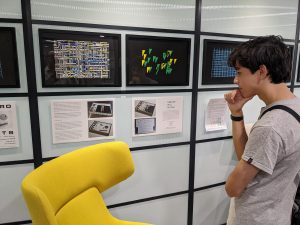

Above: Geoff Davis at exhibition with live running 1980s generative art and print displays

Above: Professor Sean Clark introducing the Micro Arts exhibition, Computer Arts Archive, at BCS Moorgate London July to October 2022
See Facebook CAS Micro Arts Group for updates.

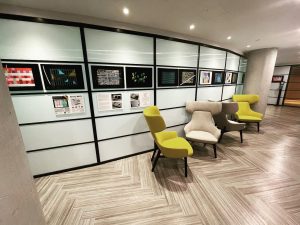
Micro Arts Group exhibition London 2022 at BCS
This is our second recent exhibition, the last was at LCB Depot, Leicester (see photos below, Geoff Davis and documentary maker and 3D videographer Patryk Jaworsky (left).
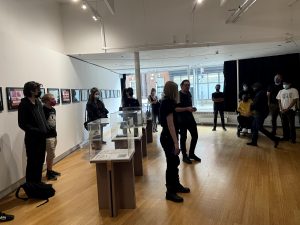
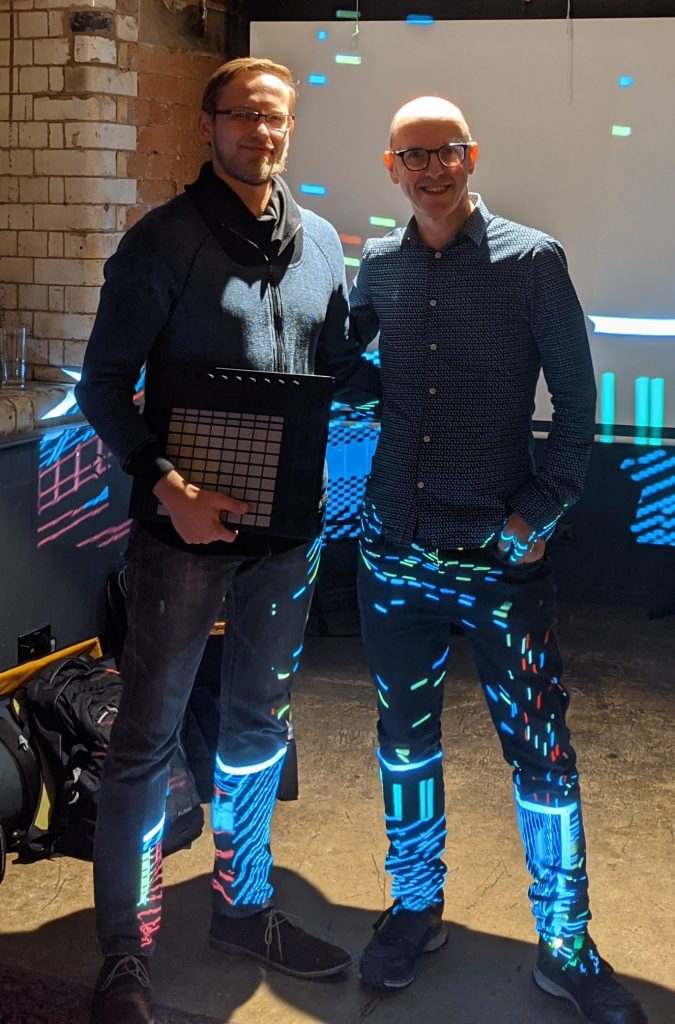
July 2023
Geoff Davis and Micro Arts Group are in THE THINKING MACHINE show from Expanded Art / Anika Meier in Berlin, June 2023. Please visit https://www.expanded.art/exhibitions/the-thinking-machine
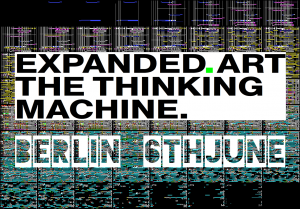
Please also visit the MA1 “Abstract Originals” (shown in Berlin above) on elementum.art curated by Georg Bak
There was also an exhibition at elementum, Zurich in February 2023.
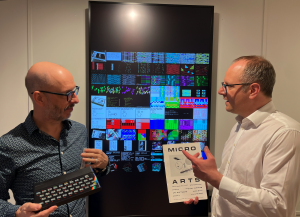
Micro Arts Group was founded in London 1984 by Geoff Davis along with many young and diverse computer artists. It made and distributed computer art, animations and text generators. There was also a Magazine, which featured the first ever Quantel Paintbox art. All of the artwork and articles were ‘online’ with Prestel teletext. Micro Arts Group is featured in the Computer Arts Archive as the first independent computer art group. It developed from Geoff’s work in the active London alternative arts scene, which included LFMC (film), LVA (video) and LMC (music). Geoff had previously been involved in the Sheffield music scene. This was well outside of the established commercial art scene and academia.
For more background please read EVA Conference paper “Revisiting and Re-presenting 1980s Micro Computer Art” by Professor Sean Clark.

Above: a few images from generated art and text – Geoff Davis
Micro Arts Group distributed digital computer art (algorithmic and generative), concept art, and story text generators, on data cassettes and later on national Prestel videotex (a pre-web viewdata or ‘teletext’ system on TV sets).
January 2022: Geoff Davis is editing a book of AI co-created fiction and poetry. Geoff is researching AI and text at CCI UAL in London. He started in this area with the Micro Arts procedural text generator MA4 Story Generator.

MA1 Cube 1-7 – Geoff Davis, Patryk Jaworski 2021
MA1 ‘Abstract Originals’ – Geoff Davis 1984 (7 generative art pieces)

Above: Micro Arts work in Computer Arts Archive 2021, Geoff Davis and Martin Rootes software releases 1984-1985
Micro Arts Group was a publisher, forum and educational resource for young computer artists from UK, France and USA. The computer art was made for public use on for home micros such as Sinclair Spectrum and BBC Micro. There was also a print magazine with many educational articles and art prints, which published the first example of Quantel Paintbox used by an artist.



Above: Quantel paintbox art 1984 from Michèle Gauthier Carr-Brown, featured in Micro Arts Magazine



MA1 Cube: Data
MA1 Cube Series – art / design by Geoff Davis from MA1 1984, videography / soundtrack by Patryk Jaworski Etalon Production. This is arriving as quad video art, sometime and somewhere in 2023.

Patryk Jaworski (L) & Geoff Davis – AV music and video event October 2021

Above: Geoff Davis / Micro Arts live generative art and these prints, at 8-bit exhibition Leicester 2021 LCB Depot
Geoff Davis is now an AI and text researcher at UAL CCI London. He has designed and produced creativity software with Story Software. He taught at several UK art colleges. He is a published author, see more about Geoff Davis books and writing. His Story Software Zooming image and notes app Notes Story Board app.
Micro Arts has been exhibited in 2021 and is in the Computer Art Archive, part of the Computer Arts Society CAS.
Micro Arts academic paper in EVA London conference 2021 – see details of Micro Arts paper here.
New work by Geoff Davis / Micro Arts is for exhibition at end 2021.
NEWS


Above: Exhibition Leicester LCB Depot 2021
There is an exhibition of Micro Arts at LCB Depot Leicester June 1 to 26.
For more info and photos see the Blog 8-bit exhibition Leicester June 2021


Micro Arts book – second edition
This is due in July 2021. If you have the first edition please contact me and I’ll send you the new one. It has the 1980s Timeline (see the menu here) in it and some news about the 2021 developments.
November 2020
Micro Arts in National Computer Arts Archive
Micro Arts is in the new Computer Arts Archive (British Computer Society)
Visit Computer Art Archive here.
Micro Arts MA1: Stripes is now the header image for the Computer Arts Society CAS Facebook page

SUMMARY
Micro Arts was founded, run and programmed by Geoff Davis, along with an diverse group of young artists and programmers. It released computer generated art, conceptual pieces and story generators on data cassettes and Prestel TV teletext, and provided a forum for computer artists and musicians. Micro computers were newly available at low cost and led to a radical change in the use and consumption of computer graphics and computer controlled systems.
BOOK – ALL FORMATS LINK – to choose your ebook format – Kindle, Apple, B&N, Kobo and more:
Sample or buy Micro Arts ebook
The range of publicly released computer art was very wide.
- generative visual art with user control – MA1 ‘Abstract Originals’ – 7 programs – see video section
- conceptual and challenging programs – MA2 ‘Various Unusual Events‘ – 6 programs
- feminist agitprop – MA2 ‘The Money Work System’ animation of the SCUM Manifesto Valerie Solanas (Andy Warhol connection). This also included a Universal Basic Income (UBI) concept used in later fiction
- math/data art – ‘Carry On Computing’ (in MA2) – January 2020 reissued as print in the code::art magazine by Sy Brand (blog on soon)
- story text generator – MA4 ‘Cow Boils Head‘ – endless fiction
- slow art – ‘Minimal‘ – 23 months to draw one screen (in MA2)
- art animations – MA3 – based on Duchamp, Mondrian and Muybridge – BBC Micro (2 MHz MOS Technology 6502/6512) – 4 programs (these by Martin Rootes, who also made animations for the Hacienda and Leadmill clubs)
Other aspects:
- had a print magazine – ‘Language as a Virus’, ‘Electronic Beowulf’, ‘Micro Music’ and many other articles
- innovative graphics for NetWork 21 pirate TV in London (Geoff) and Manchester Hacienda, Sheffield Leadmill (Martin)
- inclusive, not exclusive, no membership, open source (before it was named) software, publicly available on national Prestel teletext and via mail order data cassettes
- widely reviewed in the national computer press such as Computing and Computer Weekly, and niche magazines like Blitz, Sinclair User etc.

Above: Quantel paintbox art 1984 from Michèle Gauthier Carr-Brown
In the early 1980s computers and computer (or ‘video’) graphics of all types were making it into public awareness. The new micro computers such as the Sinclair Spectrum, Amiga, BBC Micro and many others were mostly used for games, although 3D journeys of exploration were arriving in cloaks of pixilated mystery. Pong, Space Invaders, Manic Miner and The Dark Crystal arrived around this period.
Micro Arts was one of the first producers of computer art and ‘creativity apps’ in 1984, presenting a wide range of generative computer art for the microcomputer, including evolving computer art, animations and generated text stories. These were distributed in compilations, to entertain and educate. The Micro Arts generated abstract art could be used to make ambient visuals, with menus to control colours, speed etc. Micro Arts also produced text story generators, animations and more.

The history of this period is summed up well by Paul Brown of the Computer Arts Society (CAS):
“My reading of this is: by the mid 1980’s the original objectives of the CAS – ie. to promote the use of computers to creatives – had become obsolete thanks to cheap ‘personal’ computing and creative apps. When CAS was relaunched 20 years later the main objective was to research, archive and maintain the history.” [1]

MA1 Geoff Davis – ‘Abstract Originals’ – one of seven generated art pieces

– one of six art pieces

MA1 Geoff Davis – ‘Abstract Originals’ – one of seven generated art pieces
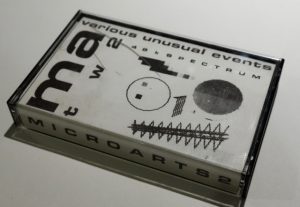
MA1, MA2, MA4 were programmed by Geoff Davis using a Spectrum 48 – a Zilog Z80 A CPU running at 3.5 MHz, with 48k of RAM. Programming was in Sinclair BASIC with ‘peeking’ and ‘poking’ values directly into the memory. MA3 was programmed by Martin Rootes on the BBC Micro.
[1] Paul Brown of CAS, email to Geoff Davis June 2019.


